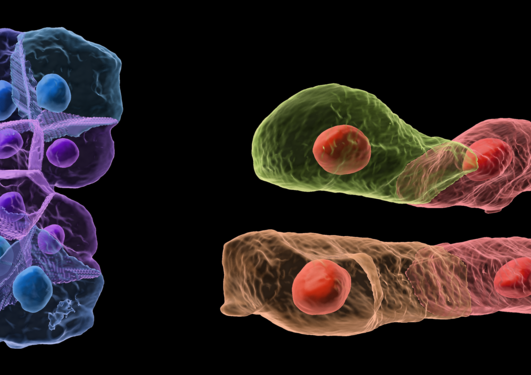Building a heart in a changing world
As the ocean warms, researchers are racing to uncover the impact of the climate crisis on marine life. In an innovative multi-scale project, developmental biologist Lionel Christiaen sets the focus on the very beginnings of life in a changing environment.

Main content
The development of an embryo is a complex and carefully orchestrated process. Over the past twenty years, the work of Michael Sars Centre Director Lionel Christiaen has made major contributions to our knowledge of this universal process.
“In our group, we study how genes tell cells to make a heart”, Christiaen explains. “Since moving to Norway, we also study how these processes are impacted by and adapt to environmental conditions in the ocean.”
The embryonic origins of the heart
After completing a PhD in Developmental Biology at the University Paris Orsay in France, Christiaen relocated to the US for a postdoctoral fellowship and later secured a professorship at the renowned New York University. There, he worked with the sea squirt Ciona, a marine organism closely related to vertebrates and highly suited to genetic and molecular studies. By expanding the array of techniques available to study Ciona, his team discovered a new model for heart development - findings that laid the groundwork for new studies on human congenital heart diseases.
“Certain heart and head muscle cells emerge from common progenitor cells”, Christiaen says. “We keep leveraging the unique strengths of the tunicate Ciona to understand the molecular mechanisms that allow these fascinating cells to migrate, divide and endow their daughter cells with the ability to choose between a heart and a head muscle identity.”

Lionel Christiaen's research group focuses on the origins of the heart during development, and on the environmental factors that may influence this process. On this image, the cells that will develop into a heart and head muscles are highlighted in red in a digital reconstruction of a larva of the sea squirt Ciona.
Marine embryos in their natural environment
Moving from New York to Bergen opened new research avenues for Christiaen. “It allowed my lab to access aquatic resources and a greater proximity to the natural habitat of animals, while operating in a full-blown research university with access to cutting-edge equipment and facilities”, he says.
The Director of the Michael Sars Centre has resolved to take advantage of the local natural resources for his next project, which explores the intimate connection between animals and their environment. “We became fascinated by the long-standing observation that embryos develop faster at higher temperatures”, he explains. "This tempo scaling indicates that even hardwired embryogenesis has built-in regulative mechanisms at the cellular and molecular scales, which we set out to uncover."
“We became fascinated by the long-standing observation that embryos develop faster at higher temperatures”
- Lionel Christiaen
Wild populations of Ciona have adapted to living across a wide range of latitudes, from the coasts of Norway to Brazil and even New Zealand. Exploring the genetic and molecular mechanisms that underly this impressive adaptability will help researchers understand how species adjust to their environment in the unprecedented context of a rapidly changing ocean.
Creating connections
Conducting a multi-scale project from molecules to organisms requires bridging scientific disciplines, building partnerships and developing cutting-edge techniques in the laboratory – areas in which the group has demonstrated an excellent track record with more than 70 publications, including in the prestigious journals Science and Nature.
“We have adopted emerging protocols to generate cardiogenic gastruloids, groups of cells which self-assemble into structures resembling early embryos”, Christiaen explains. “We are pushing the limits of our expertise in computational biology, microscopy, but also population genomics”.
The ambitious project will include field work across Europe, channeling new and existing collaborations with the European Molecular Biology Laboratory (EMBL), the Norwegian node of the European Marine Biological Resource Center (EMBRC-NO), as well as local partners at the University of Bergen.
“This new research project unites my interests in cell and developmental biology with my "first love" for ecology and evolution”, Christiaen concluded. “By generating new knowledge at uncharted scales in marine life sciences, we will be able to monitor, and perhaps mitigate, the impacts of anthropogenic insults to the oceans.”
